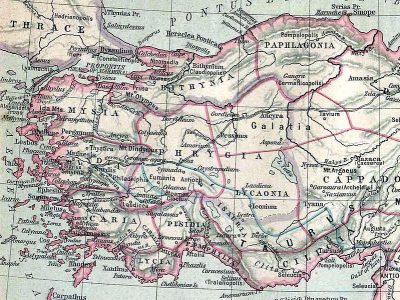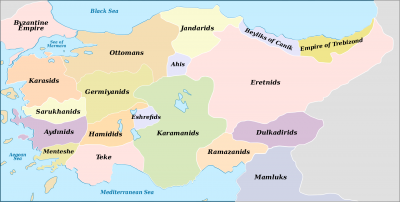Toponym
Isparta is a Turkish spelling of Greek Sparta. There are different theories about the origin and meaning of the toponym.
In Byzantine times the town was called Báris (Βάρις) or Sbárita, in Ottoman times Hamid, after the Beylik Hamidoğulları that existed here in the 14th century. In 1846, the city was given the name Hamidabad and became the administrative seat of a sancak.
Administration
The sancak comprised the region around the town of Isparta, which was ruled by the Hamidids, an autonomous Turkish dynasty that submitted to the Ottomans in 1390 or 1391/92. It became part of the Anatolia Eyalet, but was lost after the Battle of Ankara (1402) and not re-incorporated into the Ottoman state until 1423. After the Anatolia Eyalet was dissolved ca. 1841, it became part of the Karaman Eyalet. It was renamed after its administative seat as the sancak of Isparta in 1880, and again as the sancak of Hamidabad in 1891.
In 1912 it comprised the five districts (kazas) of Isparta proper, Uluborlu, Egridir, Karaağaç, and Yalvaç.
Population
In 1846, the population of Hamidabad was 6,310; in 1869, the population was 11,560. According to the Konya Province Yearbook of 1882, 33,109 people lived in sancak of Hamidabad, of whom 4,524 were Greeks and 551 were Armenians.
According to the 1914 Ottoman population statistics, the district of Isparta had a total population of 54,465, consisting of 46,698 Muslims, 6,648 Greeks and 1,119 Armenians.[1] This corresponds largely with the census of the Armenian Patriarchate of 1,180 Armenians.[2]
History
The area around Isparta has been inhabited since the Paleolithic period. The first written sources prove the existence of settlements of the Pisidians, Luwians and Arzawians in the region. In the 2nd millennium B.C. the Hittites tried to bring the area under their control, but they did not succeed permanently. From 1000 B.C. the Phrygians migrated and replaced the Pisidians. In the 8th century B.C. the area belonged to Lydia. In 541 B.C. the Persians under King Cyrus II conquered Lydia. At that time, a settlement called Baris is said to have already existed. Alexander the Great took possession of the area after conquering Sagalassos in 334/332 B.C. After his death it was part of the kingdom of Pergamon until the last king of Pergamon, Attalos III, bequeathed it to the Romans.
At an early stage Sparta became a religious center of the Anatolikon Thema and a Christian bishopric, a suffragan of the Metropolitan see of Antioch of Pisidia, the capital of the province. The names of two of its bishops are known with certainty: Heraclius participated in the First Council of Nicaea in 325 and Leo in the Second Council of Nicaea in 787. Like most sees in Asia Minor, it faded away.
During the Arab invasions of the 8th century, Baris was conquered by the Abbasids in 774, but was soon recaptured by Byzantium. The Arab raids continued until the 10th century and hindered the development of the town. In 1203 (or 1204) Baris was conquered by the Rum Seljuks under Suleiman II. After the death of the last Seljuk ruler in 1307, the Hamidids of the principality (Trk.: Beylik) Hamidoğulları took over the rule of Baris and named the town ‘Hamid’. In 1324 Hamid was briefly conquered by the Mongols, but by 1328 the Hamidoğulları ruled again. The last of the Hamidoğulları dynasty, Hamitoğlu Kemaleddin Hü-seyin Bey, sold his principality to the Ottoman Sultan Murad I for 80,000 gold pieces in 1374 (other sources: 1381), and with Hüseyin’s death in 1390, the city fell to the Ottoman Empire and became part of Beylerbey Anatolia as the sancak Hamid.
Due to the Celali uprisings in the 16th and 17th centuries, the town suffered great damage. Several earthquakes during this period destroyed numerous buildings.
After the Russo-Ottoman War of 1877-1878, many Turks emigrated from Bulgaria and settled in what is now Turkey. Turks from the Bulgarian town of Kazanlak settled in Isparta and brought with them their knowledge of producing rose oil. In 1888, Müftüzade İsmail smuggled a sappling of the Bulgarian oil rose (Rosa damascena trigintipetala) to Isparta and had it cultivated there on a large scale, so that the city became the Turkish Rose City (Şehir Gül).
After the end of the First World War, Isparta was annexed to the Italian zone under the Treaty of Sèvres. Italian troops marched towards Burdur and reached Isparta on 28 June 1919. A Turkish uprising in the city, which lasted until August 1919, led to the retreat of the Italian troops to Antalya.
Destruction
„The 200 Armenians of Adalia, the 500 of Elmaly, and the 1,180 of Isparta were spared, possibly thanks to the mutesarifs of Adalia, Kamil Bey (who held his post from 3 September 1913 to 3 April 1916), and Isparta, Hakkı Kılıc Bey (who held his post from 5 November 1914 to 28 December 1915).”[3]
On 13 December 1921, more than 2,500 Christians were deported from (I)Sparta, Burdur, Ordu, Giresun, Amasya and “Endemis” [Edremit?] to Bitlis: “But some had remained in Cesarea and Sivas for several months and now were being deported a second time to Bitlis. They were more than 2,500 when they left Cesarea, but many died on the way from starvation and cold. They were all robbed on the journey, so that they were in a terrible condition.
LATER. In spite of their condition they were sent on three days later in the midst of a heavy snowstorm.”[4]
In 1923, the town’ s Greek population was expelled due to the Treaty of Lausanne. At the same time, Turks who had been expelled from Bulgaria settled again and revived the rose oil industry.

